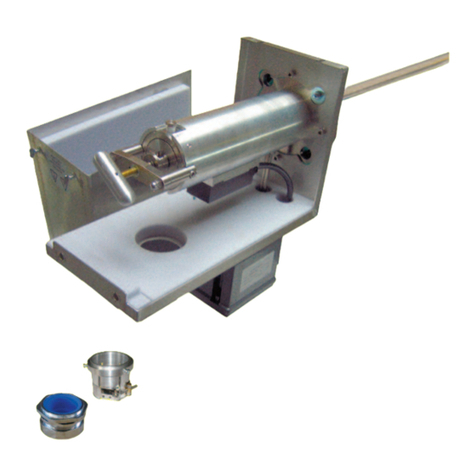
Manual JES-301/JES-301V
BA_DE_JES301_v2.1 ––––––––––––––– [ 3 / 34 ] –––––––––––––––––
Einleitung1.
Die beheizte Gasentnahmesonde JES-301 dient zur
kontinuierlichen Entnahme von staub- und aerosol-hal-
tigen Gasen bei extraktiven Analysensystemen. Wasser-
dampf und hohe korrosive Gasfeuchte müssen über
dem Taupunkt gehalten werden, damit keine Verände-
rung des Gases vor den Analysengeräten oder der Pro-
benaufbereitung stattfinden kann.
Die Gasentnahmesonde JES-301 ist in verschiedenen
Versionen lieferbar. Dadurch können unterschiedliche
Anforderungen erfüllt werden.
Die JES-301 ist mit einem großflächigen, austauschba-
ren beheizten Keramik- ilterelement ausgestattet. Das
ilterelement ist in einem elektrisch beheizten Edelstahl-
gehäuse montiert und zusätzlich in einem thermisch iso-
lierten Wetterschutzgehäuse untergebracht. Die
JES-301V sind zusätzlich mit einem Prozessabsperr-
ventil ausgestattet. Die Temperaturregelung erfolgt
durch eine wartungsfreie vollelektronische Regelung mit
Alarmmeldung bei Untertemperatur. Die beheizte Mess-
gasleitung der Serie JH wird direkt am Gehäuse der
Sonde über eine verschiebbare PG42 Verschraubung
montiert. ür die Montage für anderer Heizleitungstypen
steht eine Montageschelle zur Verfügung. ür eine kor-
rekte und optimale Auswahl der verschiedenen Entnah-
merohre und Materialien steht Ihnen unser geschultes
Personal gerne zur Seite.
ontage1.1.
Die Gasentnahmesonde besteht aus dem beheiztem il-
terkopf, Temperaturregler, Montageflansch und Monta-
gematerial. Sie kann horizontal oder vertikal montiert
werden. Die Sonde wird direkt an einem Standard-Pro-
zessflansch montiert. Wenn die Montage horizontal er-
folgt, sollte die JES-301 zumindest zwischen 5° und 15°
aus der Horizontalen fallend eingebaut werden, damit
anfallendes Kondensat zurück in den Prozess abgeleitet
werden kann.
odular1.2.
Unterschiedliche Entnahmerohrmaterialien, elektrisch
beheizte Entnahmerohre und große Vorfilter machen die
JES-301 anpassungsfähig für verschiedenste Applika-
tionen.
Service und Sicherheit1.3.
Ein Statuskontakt signalisiert Störung und Untertempe-
ratur, eine Übertemperaturbegrenzung schützt vor Über-
hitzung. Der ilterwechsel kann ohne Werkzeug und
ohne Demontage der beheizten Messgasleitung durch-
geführt werden.
Allgemeine Sicherheitsinformation1.4.
Die Gasentnahmesonden sind hochentwickelte Geräte,
die nur von qualifiziertem Personal bedient werden dür-
fen. Es ist notwendig, dass dieses Handbuch von jenen,
die diese Ausrüstung installieren, benutzen bzw. warten,
gelesen und verstanden wurde.
Introduction1.
The heated gas sampling probe JES-301 is designed for
continuous use in extractive sampling systems even
when the sample contains dust and aerosols. Water va-
pour and high corrosive gases must be kept above their
dew point to prevent corrosion and sample degradation
prior to the analysis or sample conditioning.
The JES-301 can be delivered in several versions to
meet user specific requirements.
The JES-301 incorporates a non-corrosive heated, re-
placeable ceramic filter element. The filter element is
mounted in an electrically heated stainless steel housing
covered by a thermal isolated weather protection enclo-
sure. The gas sampling probes JES-301V also include
a built-in process shut-off valve. The temperature regu-
lation is done by a maintenance free, fully electronic tem-
perature controller with under temperature alarm.The
heated sample hose JH series is directly connected with
a moveable PG42 cable conduit on the probes housing.
A universal mounting clamp is available to connect other
types of heated sample hoses. or proper selection of
various sample pipe constructions and materials please
refer to our trained staff.
ounting1.1.
The complete unit consists of the heated filter head, tem-
perature controller, mounting flange and installation ma-
terial. Mounting can be done in a horizontal or vertical
position. The probe´s design fits for mounting directly to
a standard flange. If the assembly takes place horizontal,
the JES-301 should be built in an angle at least between
5° and 15° from the horizontal falling, to allow conden-
sate flow back into the process.
Versatile1.2.
Different sample pipe materials, electrically heated sam-
ple pipes and large pre filters make the JES-301 very fle-
xible for different applications.
Service and security1.3.
A temperature status contact signalizes fault and under
temperature, an over temperature protection avoids
overheating. ilter replacement can be done easily wit-
hout any tools and without disconnecting the heated
sample line.
General safety information1.4.
Gas sample probes are sophisticated devices intended
for use by qualified personnel only. It is necessary that
this manual is been read and understood by those who
will install, use and maintain this equipment.






























